1995 OLDSMOBILE SILHOUETTE trailer
[x] Cancel search: trailerPage 92 of 390
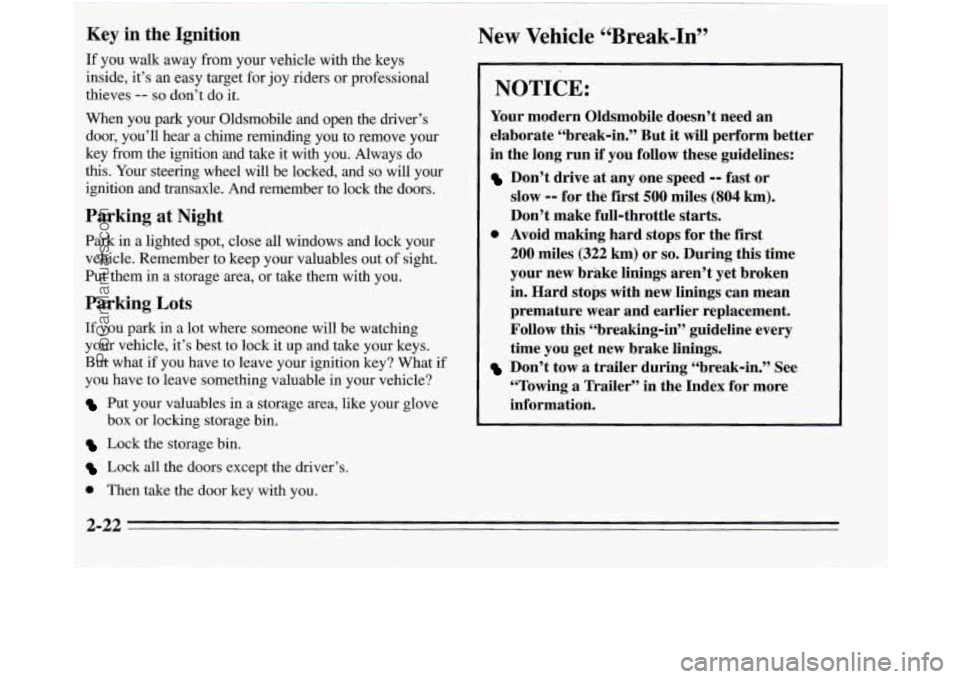
Key in the Ignition
If you walk away from your vehicle with the keys
inside, it’s an easy target for joy riders or professional
thieves
-- so don’t do it.
New Vehicle ''Break-in"
When you park your Oldsmobile and open the driver’s
door’ you’ll hear a chime reminding you to remove your
key from the ignition and take it with you. Always
do
this. Your steering wheel will be locked, and so will your
ignition and transaxle. And remember to lock the doors.
Parking at Night
Park in a lighted spot, close all windows and lock your
vehicle. Remember to keep your valuables out
of sight.
Put them in a storage area, or take them with you.
Parking Lots
If you park in a lot where someone will be watching
your vehicle, it’s best to lock it up and take your keys.
But what if you have to leave your ignition key? What if
you have
to leave something valuable in your vehicle?
Put your valuables in a storage area, like your glove
box or locking storage bin.
Lock the storage bin.
Lock all the doors except the driver’s.
0 Then take the door key with you.
NOTICE:
Your modern Oldsmobile doesn’t need an
elaborate “break-in.” But it
will perform better
in the long run if you follow these guidelines:
Don’t drive at any one speed -- fast or
slow
-- for the first 500 miles (804 km).
Don’t make full-throttle starts.
200 miles (322 km) or so. During this time
your new brake linings aren’t yet broken
in. Hard stops with new linings can mean
premature wear and earlier replacement.
Follow this “breaking-in” guideline every
time you get new brake linings.
Don’t tow a trailer during “break-in.” See
“Towing
a Trailer” in the Index for more
information.
0 Avoid making hard stops for the first
2-22
ProCarManuals.com
Page 101 of 390

If your automatic transaxle has OVERDRIVE (@),
NOTICE: THIRD (D) is like OVERDRIVE (D), but you never go
into Overdrive. Here are some times you might choose
This NOTICE applies only if you have the 3800 THIRD (D) instead of OVERDRIVE (@):
V6 engine and the automatic overdrive transaxle.
If your vehicle is so equipped, and if it seems to 0 When driving on hilly, winding roads.
start up rather slowly, or if it seems not to shift
far that way, your vehicle can be damaged. So, if
When going down a steep hill. with a transaxle system sensor. If you drive very
between gears. gears as you go faster, something may be wrong
When towing a trailer, so there is less shifting
this happens, have your vehicle serviced right SECOND GEAR (2): This position
gives you
away. Until then, you can use SECOND (2) when more power, but lower fuel economy. You can use
SECOND
(2) on hills. It can help control your speed as you are driving less than 35 mph (56 km/h) and you go down steep mountain roads, but then you would
OVERDRIVE (0) for higher speeds. also want to use your brakes off and on.
THIRD GEAR (D): If your automatic transaxle does
not have
OVERDRIVE (@), this position is for normal
driving, at all speeds, in most street and highway
situations. NOTICE:
Don’t drive in SECOND (2) for more than 5 miles
(8 km), or at speeds over 55 mph (88 km/h), or
you can damage your transaxle. Use THIRD (D)
(OVERDRIVE (a) or THIRD (D) if your vehicle
has OVERDRIVE
(a)) as much as possible.
Don’t shift into SECOND
(2) unless you are going
slower than 65 mph
(105 km/h), or you can
damage your engine.
2-31
ProCarManuals.com
Page 103 of 390
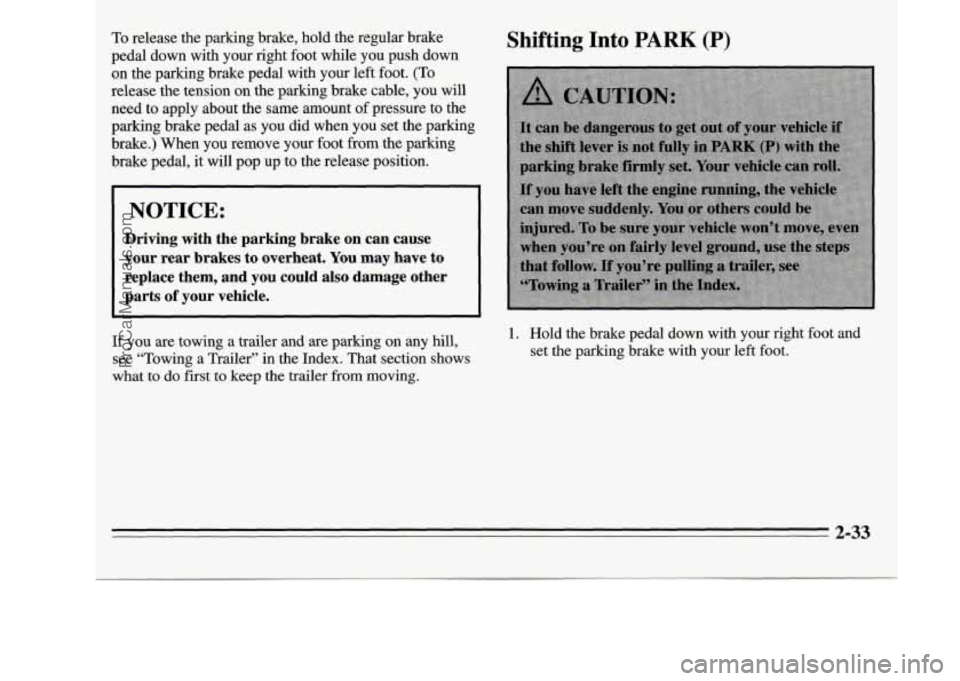
To release the parking brake, hold the regular brake
pedal down with your right foot while you push down
on the parking brake pedal with your left foot.
(To
release the tension on the parking brake cable, you will
need to apply about the same amount of pressure to the
parking brake pedal as you did when you set the parking
brake.) When
you remove your foot from the parking
brake pedal, it will pop up
to the release position.
I NOTICE:
Driving with the parking brake on can cause
your rear brakes to overheat.
You may have to
replace them, and
you could also damage other
parts
of your vehicle.
Shifting Into PARK (P)
If you are towing a trailer and are parking on any hill,
see “Towing a Trailer” in the Index. That section shows
1. Hold the brake pedal down with your right foot and
set the parking brake with
your left foot.
what to do first to keep the trailer
from moving.
2-33
ProCarManuals.com
Page 108 of 390
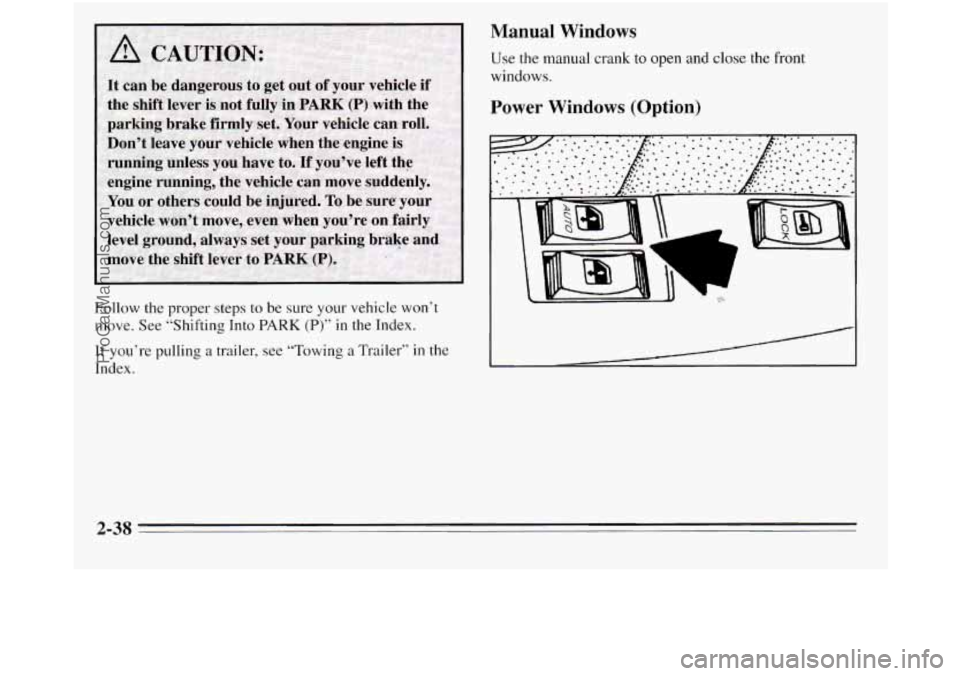
Follow the proper steps to be sure your vehicle won’t
move. See “Shifting Into PARK (P)” in the Index.
If you’re pulling a trailer, see “Towing a Trailer” in the
Index.
Manual Windows
Use the manual crank to open and close the front
windows.
?ower Windows (Option)
2-38
ProCarManuals.com
Page 111 of 390
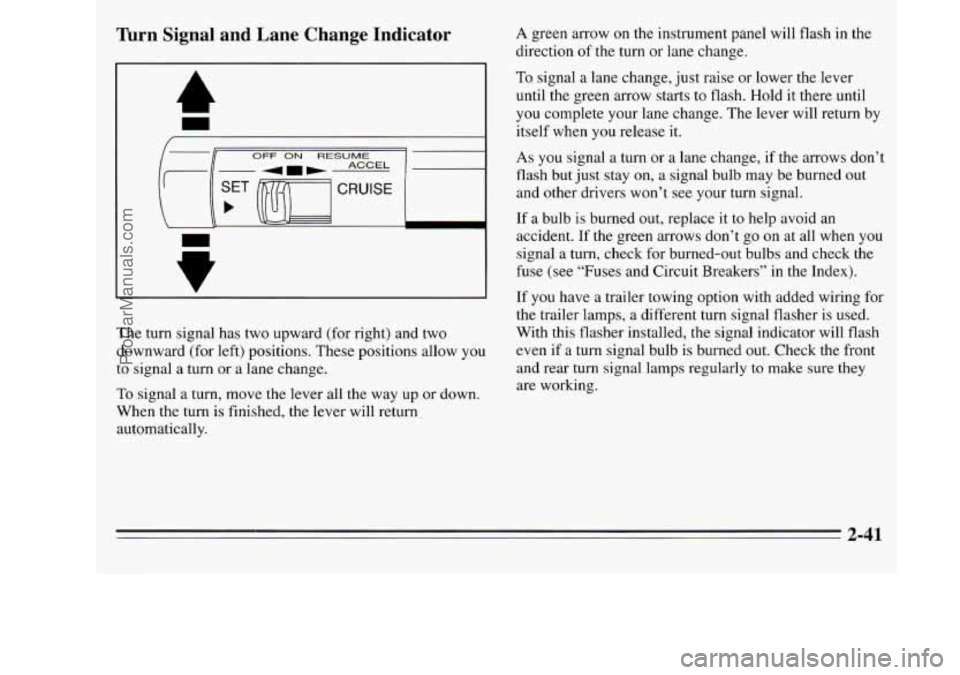
mrn Signal and Lane Change Indicator
OFF ON RESUME
The turn signal has two upward (for right) and two
downward (for left) positions. These positions allow you
to signal a turn or a lane change.
To signal a turn, move the lever all the way up or down.
When the turn is finished, the lever will return,
automatically.
A green arrow on the instrument panel will flash in the
direction
of the turn or lane change.
To signal a lane change, just raise or lower the lever
until the green arrow starts to flash. Hold it there until
you complete your lane change. The lever will return by
itself when you release it.
As you signal a turn or a lane change, if the arrows don’t
flash but just stay on, a signal bulb may be burned out
and other drivers won’t
see your turn signal.
If a bulb
is burned out, replace it to help avoid an
accident. If the green arrows don’t go on at all when
you
signal a turn, check for burned-out bulbs and check the
fuse
(see “Fuses and Circuit Breakers” in the Index).
If you have a trailer towing option with added wiring for
the trailer lamps, a different turn signal flasher is used.
With this flasher installed, the signal indicator will flash
even if
a turn signal bulb is burned out. Check the front
and rear turn signal lamps regularly
to make sure they
are working.
2-41
ProCarManuals.com
Page 213 of 390
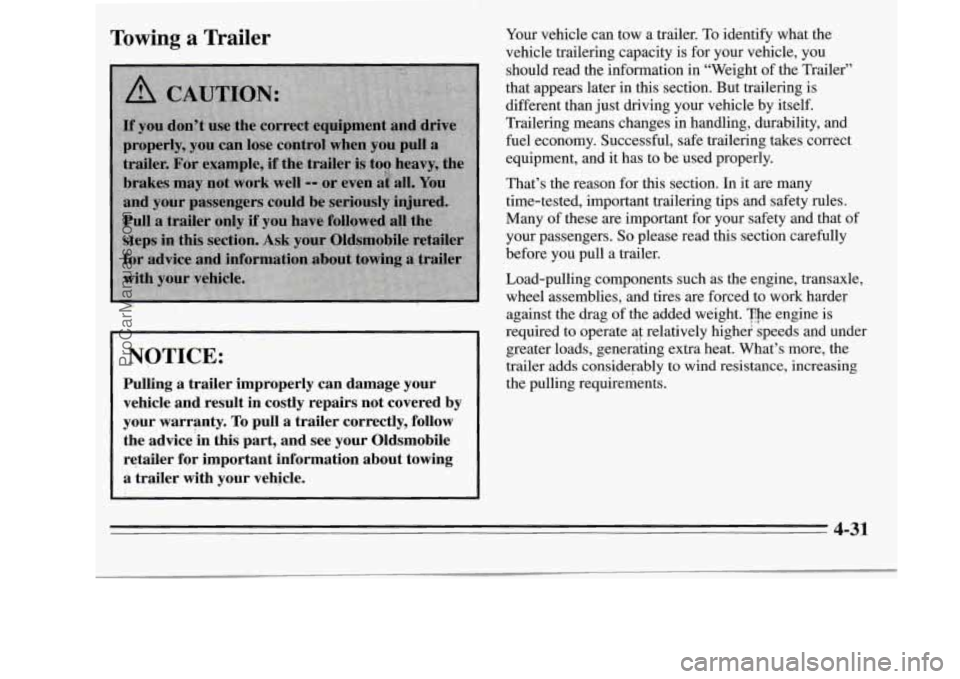
Towing a Trailer
NOTICE:
Pulling a trailer improperly can damage your vehicle and’result in costly repairs not covered by
your warranty.
To pull a trailer correctly, follow
the advice‘in this part, and see your Oldsmobile
retailer for important information about towing a trailer with your vehicle.
Your vehicle can tow a trailer. To identify what the
vehicle trailering capacity is for your vehicle, you
should read the information in “Weight of the Trailer”
that appears later in this section. But trailering is
different than just driving your vehicle by itself.
Trailering means changes in handling, durability, and
fuel economy. Successful, safe trailering takes correct
equipment, and it has to be used properly.
That’s the reason for this section. In it are many
time-tested, important trailering tips and safety rules.
Many of these are important for your safety and that of
your passengers.
So please read this section carefully
before you pull a trailer.
Load-pulling components such as the engine, transaxle,
wheel assemblies, and tires are forced to work harder
against the drag of the added weight. The engine is
required
‘to operate ai relatively highei speeds and under
greater loads, generating extra heat. What’s more, the
trailer adds considerably to wind resistance, increasing
the pulling requirements.
4-31
ProCarManuals.com
Page 214 of 390
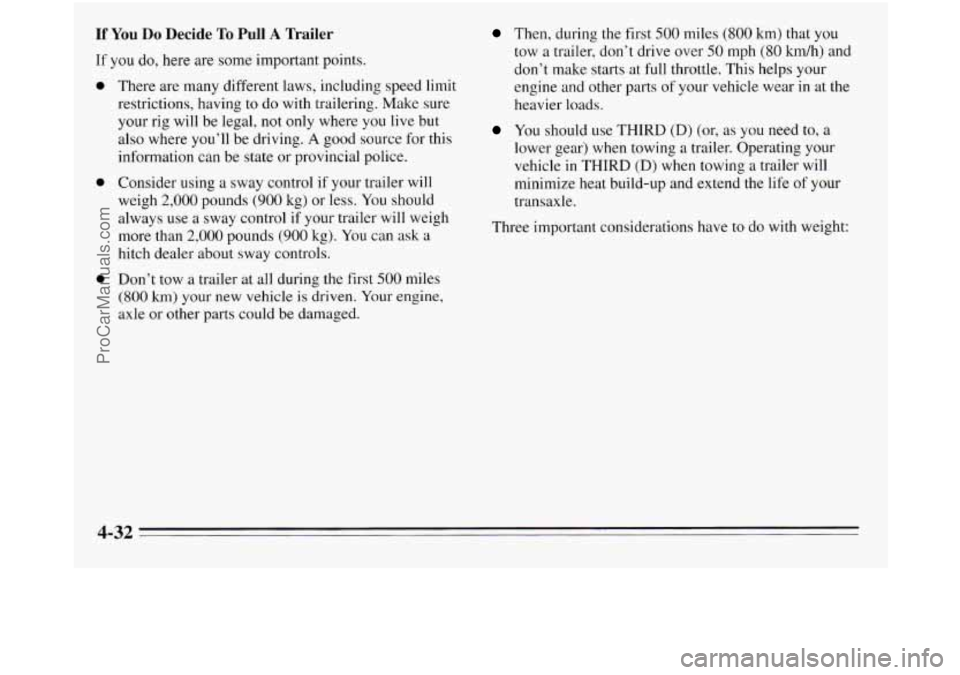
If You Do Decide To Pull A Trailer
If you do, here are some important points.
a
a
0
There are many different laws, including speed limit
restrictions, having to do with trailering. Make sure
your rig will be legal, not only where you live but
also where you’ll be driving.
A good source for this
information can be state or provincial police.
Consider using a sway control if your trailer will
weigh
2,000 pounds (900 kg) or less. You should
always use a sway control if your trailer will weigh
more than
2,000 pounds (900 kg). You can ask a
hitch dealer about sway controls.
Don’t tow a trailer at all during the first
500 miles
(800 km) your new vehicle is driven. Your engine,
axle or other Parts could be damaged.
Then, during the first 500 miles (800 km) that you
tow a trailer, don’t drive over
50 mph (80 ludh) and
don’t make starts at full throttle. This helps your
engine and other parts of your vehicle wear in at the
heavier loads.
You should use THIRD (D) (or, as you need to, a
lower gear) when towing a trailer. Operating your
vehicle
in THIRD (D) when towing a trailer will
minimize heat build-up and extend the life of your
transaxle.
Three important considerations have to
do with weight:
4-32
ProCarManuals.com
Page 215 of 390
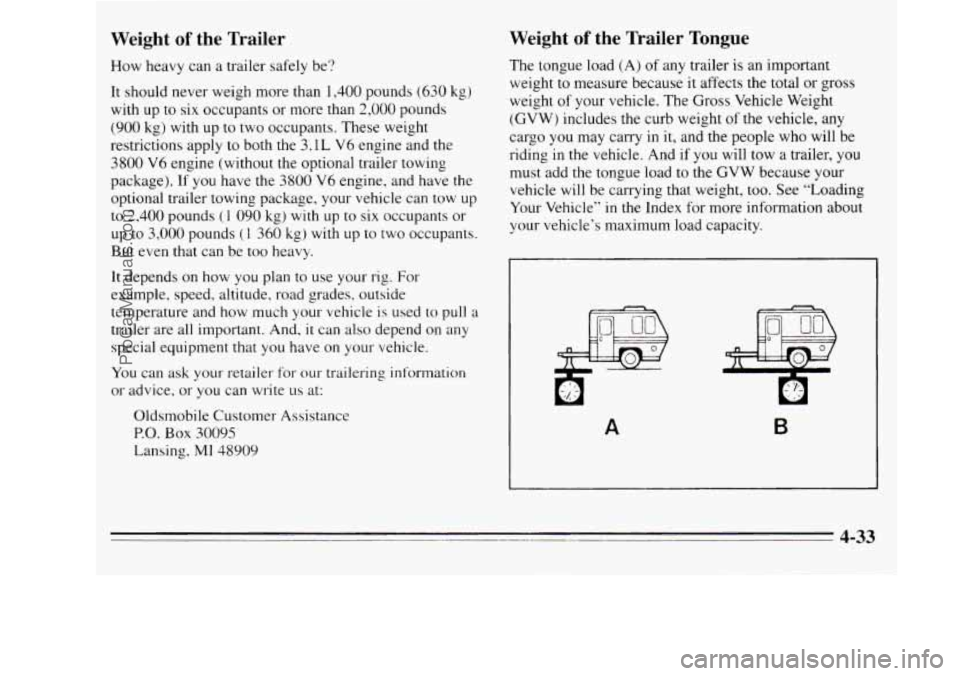
Weight of the Trailer
How heavy can a trailer safely be?
It should never weigh more than 1,400 pounds (630 kg)
with up to six occupants or more than 2,000 pounds
(900 kg) with up to two occupants. These weight
restrictions apply to both the
3.1L V6 engine and the
3800 V6 engine (without the optional trailer towing
package).
If you have the 3800 V6 engine, and have the
optional trailer towing package, your vehicle can tow up
to 2,400 pounds
(I 090 kg) with up to six occupants or
up
to 3,000 pounds (1 360 kg) with up to two occupants.
But even that can be too heavy.
It depends on how you plan to use your rig. For
example, speed, altitude, road grades, outside
temperature and how much your vehicle is used to pull
a
trailer are all important. And, it can also depend on any
special equipment that
you have on your vehicle.
You can ask your retailer for our trailering information
or advice, or
you can write us at:
Oldsmobile Customer Assistance
P.O. Box 30095
Lansing,
MI 48909
Weight of the Trailer Tongue
The tongue load (A) of any trailer is an important
weight to measure because it affects the total
or gross
weight
of your vehicle. The Gross Vehicle Weight
(GVW) includes the curb weight of the vehicle, any
cargo you may carry
in it, and the people who will be
riding in the vehicle. And
if you will tow a trailer, you
must add the tongue load to the GVW because your
vehicle will be carrying that weight,
too. See “Loading
Your Vehicle” in the Index for more information about
your vehicle’s maximum load capacity.
A B
4-33
ProCarManuals.com